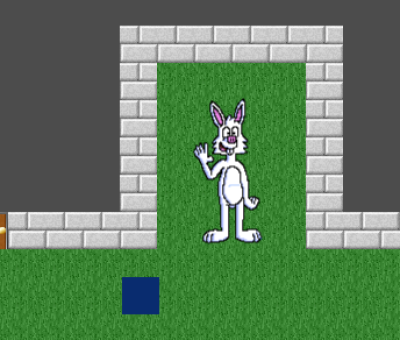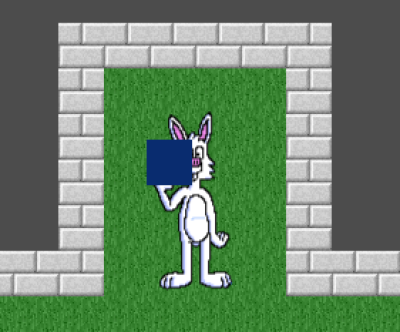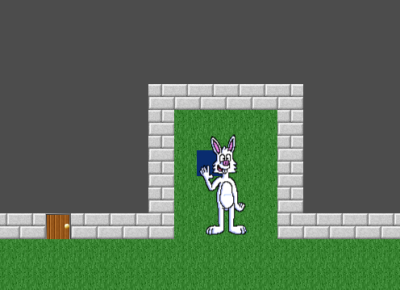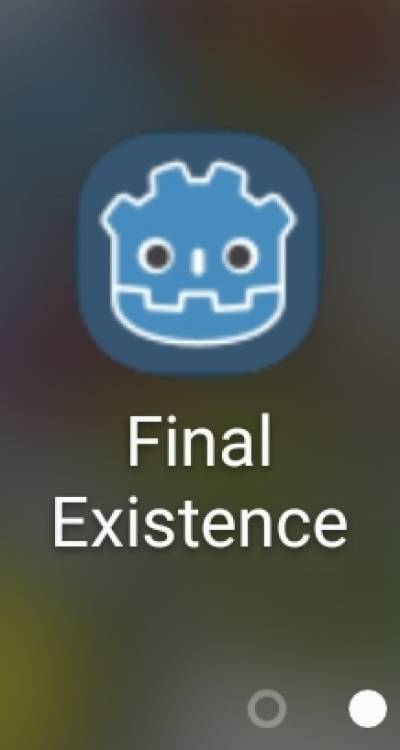Godot learning
I did these between 2019-07-28 and 2019-088-17. I never made that game.
Part 1
I'm learning how to use the Godot game engine and so I'm going to start keeping my notes on my blog so I can remember them, and hopefully gather resources that may help you.
My goal is to rebuild an ancient RPG I made called Final Existence on the Amiga in AMOS Basic, which was a YA alternate universe apocalyptic game that looked and felt a lot like Chrono Trigger. I've become a bigger fan of ARPGs lately, and I'll rebuild it using that paradigm.
There are a crap ton of tutorials out there, but I've been having trouble gathering all the pieces I want together to build an ARPG, and there's a lot of moving parts in Godot, so this is my attempt to wrangle all that together in one place for myself.
So, on with the notes:
What do I (think I) need next?
TileMap/Area2Dcollisions for making the character walk around and get stopped by things, and know what I ran into.- A map that's bigger than the screen that follows the character around.
What have I found?
- Started with Your First Game to get a handle on editor in general
- GDScript is very Python-y, which is not my strongest language, but I'm getting the hang of it
- I wish Godot had vim keyboard shortcut support
- Learned TileMap and TileSet because I plan on using tiles to make maps
- Still need to figure out how to get things to run into tiles
- Walked through Kinematic Character 2D
- The official docs
- Using KinematicBody2D on KidsCanCode
- Still think I'm missing something with this:
- Can't quite get the character to walk/move as expected
- Also this is more platformer-y than I need right now
- Watching Top-down RPG/Adventure in Godot
-
- Looks like gettext
- Switch scenes via “NPC” with a Screen Change custom event
export varto select target sceneexport varfor warp target in other scene- Remove old scene from DOM
get_tree().root.get_child()/.add_child()Scene#queue_freeto safely remove from memory!
- Add new scene to DOM
- Find player in new scene
- Move to position of warp target
- Put nodes into a group called “exit” to focus the search
- Dialog box
- Move it out of the way if the character is there
- The scene will need a camera
- Find the Camera2D
- Only one camera in a scene, pick one using
Camera2D#make_current() - Put the camera in the thing that needs to be tracked
- Drag margins require tracked object to hit edges before moving
- Make the camera current, or nothing will move
- Clamp the camera scroll to the size of screen with
Camera2D#limit_??- Grab the dimensions of something that's as big as the scene
- Can you get scene/child node offset size
- Player move from scene to scene
- Primarily to transfer player state
- Video shows physically moving player node, since Player object contains state, but I'm thinking to have a Vuex/Redux like store external to visual scenes where such data can be stored and reconstituted
- Moving nodes from Scene to Scene seems error-prone, more reason for external state
-
- Like Ruby meets C?
- Using separate TileMaps
- One for walkable areas, one for collisions, one for stuff outside the play area
-
- Emit a signal on transport to recalculate camera clamping
-
Solution to "RPG Map with tiles and doors"
Node2DMainscene withKinematicBody2DPlayerandNode2DMapContainerMapContainercontains the firstMapPlayerhandles own position, usingmove_and_collideto detect collisions, andmove_and_slideto complete moves after initial collisions.Playergets collisionNodeand determines if it is aDoorDooris a subclass ofKinematicBody2Dwith the exported propertiesDestinationScenePath : StringandExitID : int.- On collision,
Playeremits a signal withDestinationScenePathandExitID
Mainlistens for collision signal fromPlayerand, once received, manually swaps out the old map inMapContainerwith the loadedDestinationScenePath…- …then searches the new scene for nodes in the
exitgroup and finds a node in that group with anExitIDproperty that matches the one received in the signal. If found, movePlayerto thatNode2D#position.
MapandMap2have nodes in this order:TileMapWalkable- Any
Doors with appropriately setDestinationScenePathandExitID TileMapWallswith tiles withCollisionenabledExitNodes, each in theexitgroup and with anExitIDthat matches theDoorfrom the other scene.
Part 2
Lunchtime video: Platform Game Tutorial
- Grid setup & snapping in top/dot menu
- Remember to use
KinematicBody2D#_physics_processto sync code with physics engine! - The
Vector2Dmotionobject:- Having a drag on horizontal motion & capping horiz motion to have inertia?
StaticBody2Ddoesn't move but it interacts with physicsCanvasItem#Modulatecan hack in a color on a thing.- Ensure you move extents of Collision shapes and leave the Transform alone.
is_on_floor()andmove_and_slide(velocity, floor_vector)Vector2(0, -1)is an up vector, which makes floors work.
velocity = move_and_slide(velocity)to set it to “remaining motion”- If you've hit the ground, there's no more remaining velocity, so you don't have to stop adding gravity yourself.
Game planning
I'm now thinking the game will be a walking simulator with QTE. No items, no stats, no tight action stuff, just dialog choices, exploration, and QTE. Should be pretty straightforward.
Solution to "Pixel size of Scene for Camera2D clamping"
This doesn't take into account transforms on the Map or the MapContainer.
python
func get_map_max_size():
var maxSize = Rect2(0,0,0,0)
for node in $MapContainer/Map.get_children():
# Object#is_class is like Ruby Object#is_a?.
# if I used instances in the tree whose classes subclassed TileMap,
# is_class will return true for those instances.
if node.is_class("TileMap"):
var mapSize = Transform2D(
Vector2(node.cell_size.x, 0),
Vector2(0, node.cell_size.y),
Vector2()
) * node.get_used_rect().size
maxSize = maxSize.expand(Vector2(mapSize.x, mapSize.y))
return maxSize
Part 3
Lunchtime Video: Branching Dialogue and Dynamic Events
- Use Nodes to group objects rather than using top level Node type (
KinematicBody2DforPlayer) PlayercanMoveandcanInteractcanMove = falsein dialogue boxescanInteract != falseif colliding withArea2DItemcontainsArea2Dfor interaction, andStaticBody2Dfor collision- On load map
_ready, find all in groupInteractibleand connect toPlayerbody_enterandbody_exit- Would need more refinement if 2+ interactible objects entered
- Facing? Distance to center of all objects?
_inputevent for capturing inputArrayPlayer#inventory
Fileto read JSON files: https://www.reddit.com/r/godot/comments/7wj5p3/need_help_reading_data_from_a_json_file/- Inkle Writer is discontinued, superceded by ink: https://www.inklestudios.com/ink/web-tutorial/
- Inky is an editor that runs on Linux…kinda
- Picking a data structure for:
- Event tracking
- Dialogue
- Other game state
Object/Arraytraversal is JavaScript-like- Dialogue/routing/game state seems finicky enough that a testing framework would be worth using
-
- Python
unittest-style - Issues with 3.1?
-
- Build the dialog box via instancing new Classes and adding to a container
Solution to "Clamp camera to max area of Map Scene"
- Emit a signal on start/map change of calculated max scene area
Playerpicks up signal and resets itsCamera2Dlimit_?properties from the providedRect2.
Solution to "Fade to black when changing rooms"
- Made a
Transitionwith aColorRectthat is black- Can use
ColorRect#self_modulate#ato change alpha
- First started with signals going back and forth between
MainandTransition- Throw around timers? Coroutines/yields?
- Reddit comment (https://www.reddit.com/r/godot/comments/8ourxn/godot_and_gdscript_the_wonders_of_yielding/) pointed me at
AnimationPlayer - Created an
AnimationPlayerwithColorRectas a child- Property transition for
ColorRect#self_modulate - Call function transition to fire off an emit to
Mainhalfway through to continue the loading - Store the map/exit ID from the door globally and grab them halfway through
- Will have to disable Player movement on transition to prevent double triggering
Part 4
Dialogue Boxes
- Separate node for running the logic of the dialogue box
- Like Vue data/computed/methods separated from template, but more manual lifting
- Player is a state machine based on input dialogue data
- DB object to get assets
- Can iterate over a
res://directory withDirectoryinstance and cursorget_next() - Can create text Resources as an alternative data storage vs. JSON/YAML
- Using YAML: https://github.com/Beliaar/godot-yaml-asset
- If we need JSON for native, switching out loaders should be easy
- GUI containers:
- Create a
CanvasLayerovertop of everything where GUIs live, otherwise they'll be affected by the viewport/Camera. - Docs say that
Containersand their children reflow automatically, but I found I had to reset settings a lot in child containers after adjusting parent containers to get them “right”.- Getting a
ColorRectto take up the whole container's background is a challenge.
MarginContainerCustom Constants is where you're setting the interior margins of the box! This is the setting you want to make aMarginContainerdo what you expect it to do!- Use
(H|V)BoxContainerswith the Size Flag set toExpandto create spacers.
Solving "Move RPG dialogue box to other end of screen to not hide player"
- Put the
DialogueBoxinside aVBoxContainer, I call itAligner. - Player is above the centerline of the viewport if
global_position.y < $Camera.get_camera_screen_center().y. - Set that on a property of
Playerduring_process, I useatTopOfScreen. - Use the
VBoxContainer'salignmentandmargin_bottomto position theDialogBox:python if $Player.atTopOfScreen: $GUI/Aligner.alignment = VBoxContainer.ALIGN_END $GUI/Aligner.margin_bottom = -100 # height of container else: $GUI/Aligner.alignment = VBoxContainer.ALIGN_BEGIN $GUI/Aligner.margin_bottom = 0
Part 5
Dialogue Boxes Part 2
- Use a combination of
Input.is_action_just_releasedand!Input.is_action_pressedwithui_acceptto find out if interaction should continue. Rough pseudocode logic:python var stopInteracting = false # only continue if everything is ok if isInteracting and isAllowedToContinueInteracting and Input.is_action_just_released("ui_accept"): emit_signal("continue_interaction", "next") isAllowedToContinueInteracting = false # have to release the key to continue if !Input.is_action_pressed("ui_accept"): isAllowedToContinueInteracting = true if canMove && !isInteracting: if interactTarget && Input.is_action_just_released("ui_accept"): isInteracting = true emit_signal("start_interaction", self) isAllowedToContinueInteracting = false if stopInteracting: isInteracting = false stopInteracting = falseThis gets a little weird with a menu system, though, as I want the
DialogBoxto control input. I may movePlayerandDialogBoxInputhandling up toMainand send it down to the appropriate objects based on game state. setgetdoesn't fire setters and getters if you are setting or getting the value in the same script, so this does not fire the setter:python # CoolCat.gd var cat setget set_cat func set_cat(newCat): cat = newCat do_cat_things() func _process(): if somethingHappens: cat = "meow" # do_cat_things is not called.
Part 6
Odds and Ends
- If you want to make a factory class method, you can't use
newin a static method:python class_name Kitten static func forCharacter(char): var kitten = new() kitten.setupCharacter(char) return kittenInstead,
loadthe file fromres://and runnewfrom that. This is to get around multithreading issues it seems:python class_name Kitten static func forCharacter(char): var kitten = load('res://classes/Kittens.gd').new() kitten.setupCharacter(char) return kitten - I hate making up/down/left/right
ifblocks for movement:python const MOVES = [ ["ui_down", "y", WALK_SPEED], ["ui_up", "y", -WALK_SPEED], ["ui_left", "x", -WALK_SPEED], ["ui_right", "x", +WALK_SPEED], ] func _process(delta): var vector = Vector2(0,0) for move in MOVES: if Input.is_action_pressed(move[0]): vector[move[1]] += move[2]
Making Pixel Art
Krita is my art tool of choice anyway, so let's see what the Internets have to say about using it for stills and animations:
-
- The newest video I could find
- Modern Krita comes with a Pixel Art brush to align the pointer with the grid
- Fill Bucket
- Threshold 1, Grow Selection 0, Feathering 0
- Disable Antialiasing on selecton tools
- Subwindows for new views
- Transform
- Nearest Neighbor
- Use wraparound (
w) for tiling backgrounds
-
- Use Alpha Lock to make shading easier
- Emulate antialiasing to make transitions between colors smoother
- I need to get better about mirroring the canvas to check symmetry…
Part 7
YSort and 2d RPG games
I made a pixel art in Krita:
![]()
Then I put him in my game:

Then I walked behind him:

Oops.
My structure of the game looks like this, because I thought
having Player outside of Map and not repeated in all the
maps would make things easier:
- Main
- Map
- Rabbit
- Player
But it should look like this, and I'll have to do more
management of Player within maps when maps change:
- Main
- Map
-
- Player
- Rabbit
-
My idea of centralizing all player input to Main and
pushing down movement events to Player may be the direction
I go for restructuring this…stay tuned.
Part 8
YSort!
Success! I got my player to walk behind the rabbit by
placing both in a YSort:

But I have to make sure everything map-related goes
into the YSort. My Exit Nodes were outside the YSort,
so when I warped back into the larger first Map,
I ended up in a weird spot. Also, moving all of the
input logic to Main and pushing down events to
Map and such is the way to go.
Next is making my TileMaps be the kind where the
player can walk “behind” them.
Android Export
I got the game to export to Android, as I already had the Android environment installed for React Native and NativeScript-Vue compilation:

I hooked up a USB controller via an OTG cable and got the game to react to inputs, but, as expected, the YAML data didn't work, so I'll need to hook up a preflight script to covert YAML to JSON and use the JSON loader on Android, or just use JSON everywhere and run a watcher to convert YAML on-the-fly while I work.